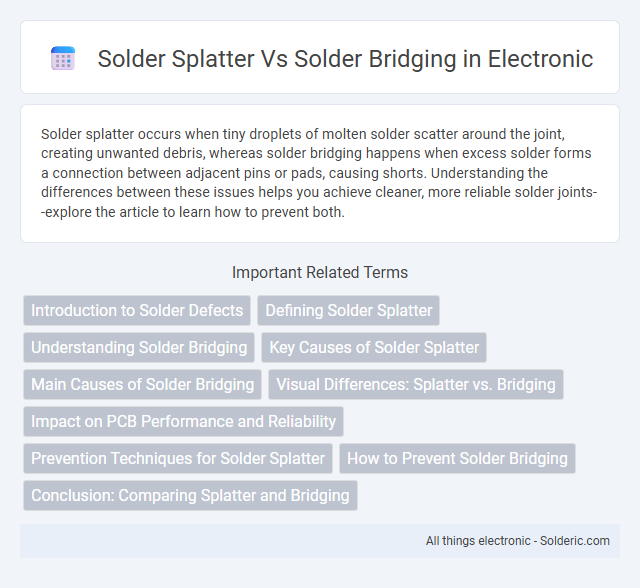Solder splatter occurs when tiny droplets of molten solder scatter around the joint, creating unwanted debris, whereas solder bridging happens when excess solder forms a connection between adjacent pins or pads, causing shorts. Understanding the differences between these issues helps you achieve cleaner, more reliable solder joints--explore the article to learn how to prevent both.
Comparison Table
| Aspect | Solder Splatter | Solder Bridging |
|---|---|---|
| Definition | Small droplets of solder scattered unintentionally around the PCB. | Unwanted solder connection joining two or more adjacent pads or pins. |
| Causes | Excessive heat, improper soldering technique, or high soldering iron temperature. | Excessive solder application, poor solder mask design, or close pin spacing. |
| Impact on PCB | Can cause shorts if droplets contact conductive areas, but often just cosmetic. | Causes electrical shorts, functional failures, and potential circuit damage. |
| Detection | Visible as tiny solder balls around the solder joint; inspected visually or by AOI. | Visible as unwanted connections between pins; detected by visual inspection or testing. |
| Prevention | Use controlled temperature, proper flux, and correct soldering technique. | Apply precise solder amount, improve PCB layout, and clean solder pads before soldering. |
| Correction | Remove splatter with solder wick or solder sucker; clean PCB surface. | Use desoldering braid or rework to remove bridges; verify isolation with multimeter. |
Introduction to Solder Defects
Solder splatter and solder bridging are common solder defects that impact electronic circuit reliability. Solder splatter refers to tiny droplets of molten solder scattered around the solder joint area, causing shorts or contamination. Solder bridging occurs when excess solder connects adjacent pins or pads, resulting in electrical shorts and compromised circuit functionality.
Defining Solder Splatter
Solder splatter refers to tiny droplets of molten solder that scatter irregularly during the soldering process, often creating unwanted small balls on the circuit board. These splatters can cause short circuits or interfere with component placement, reducing the reliability of electronic assemblies. Unlike solder bridging, which forms unintended connections between adjacent terminals, solder splatter is more dispersed and unpredictable, requiring careful control of soldering temperature and technique.
Understanding Solder Bridging
Solder bridging occurs when excess solder creates an unintended electrical connection between two adjacent pads or components, leading to short circuits and potential device failure. This issue differs from solder splatter, which involves small droplets of solder scattered around the board without forming connections. Understanding solder bridging is crucial for maintaining your PCB's reliability and ensuring optimal circuit performance.
Key Causes of Solder Splatter
Key causes of solder splatter include excessive heat applied to the soldering iron, improper flux usage, and solder wire fed too quickly or inconsistently. Contaminated or oxidized soldering tips can also lead to inconsistent melting, resulting in splatter. Additionally, using the wrong solder alloy or insufficient temperature control can cause solder droplets to scatter, creating splatter defects.
Main Causes of Solder Bridging
Solder bridging primarily occurs due to excessive solder application, improper PCB pad design, or insufficient heat control during the soldering process. Contaminants on the PCB surface and misaligned components can also contribute to the formation of unintended solder connections between adjacent pads. These factors lead to electrical shorts and critical circuit failures in electronic assembly.
Visual Differences: Splatter vs. Bridging
Solder splatter appears as small, irregular droplets scattered around the solder joint, often creating a messy and uncontrolled look on the circuit board. In contrast, solder bridging is characterized by an unintended metallic connection between two or more adjacent solder pads or pins, forming a visible bridge that can cause short circuits. Visually, splatter resembles random specks dispersed apart, while bridging shows a continuous, solid connection path between components.
Impact on PCB Performance and Reliability
Solder splatter can cause short circuits by creating unintended conductive paths on a PCB, leading to intermittent or permanent failures in electronic circuits. Solder bridging directly connects adjacent pads or pins, resulting in signal integrity issues and potential device malfunction or damage. Both defects compromise PCB performance and reliability, increasing the risk of circuit shorts, erratic behavior, and reduced lifespan of electronic assemblies.
Prevention Techniques for Solder Splatter
Solder splatter prevention techniques include controlling the soldering iron temperature, using flux appropriately, and maintaining proper soldering speed to minimize blobs and tiny solder particles. Applying a solder mask can protect sensitive areas from unintended solder deposits, while cleaning the soldering tip regularly reduces the risk of splatter caused by burnt flux or debris. Employing precise solder wire feed and using anti-splatter sprays further ensure clean and controlled solder joints, reducing defects and rework in PCB assembly.
How to Prevent Solder Bridging
Solder bridging occurs when excess solder creates unwanted connections between adjacent pads or pins, causing short circuits and device malfunction. To prevent solder bridging, ensure precise temperature control on your soldering iron, use fine-tipped soldering tools, and apply minimal solder with steady hand movements. Proper PCB design with adequate pad spacing and the use of solder mask can significantly reduce the risk of solder splatter and bridging, protecting your electronic assemblies.
Conclusion: Comparing Splatter and Bridging
Solder splatter creates unwanted blobs of solder on the PCB, potentially causing short circuits and damaging components, while solder bridging forms unintended electrical connections between pads or traces, leading to circuit failures. Both defects hinder the reliability and functionality of your electronic assemblies, but bridging directly compromises circuit integrity by creating unintended conductors. Preventing these issues involves precise temperature control, clean soldering surfaces, and proper solder application techniques.
Solder splatter vs solder bridging Infographic

 solderic.com
solderic.com